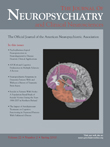Recurrent Episodes of Stroke-Like Symptoms Due to Accidental Intoxication With Doxepin
To the Editor: Tricyclic antidepressants are used for treatment of mood disorders, anxiety, sleep disturbance, pain and psychosomatic symptoms. 1 Intoxication can lead to disorientation, hallucinations, unconsciousness, seizures, apnea, hypotension and conduction defects in the heart. 2 Here, we report a patient presenting repeatedly with stroke-like symptoms due to accidental doxepin intoxication underscoring the importance of a careful assessment of the patient’s drug history including hands-on examination of the actual medication.
Case Report
A 64-year-old man with non-insulin-dependent diabetes mellitus was repeatedly referred to the emergency room presenting recurrent episodes of headache, dizziness, vertigo, impairment of gaze and speech, loss of balance, nausea, and muscle weakness. Neurological examination constantly revealed a somnolent patient with nystagmus, gait ataxia, dysarthria, dysmetric coordination, and general weakness without unambiguous paresis, sensory deficit, or reflex abnormalities. When the patient first presented, we suspected stroke, and he was monitored on our stroke unit for 24 hours. A peripheral vestibular disease was excluded by caloric testing. However, MRI scans showed no sign of fresh ischemia, intracerebral bleeding, or stenosis of cerebral arteries. A lumbar puncture revealed normal findings, and cardiologic examination showed no pathologies except for a patent foramen ovale without aneurysm. Since symptoms disappeared within 24 hours, the patient was diagnosed with a transitory ischemic attack and released with 100 mg/day of acetylsalicylic acid. A few days later, he returned with exactly the same symptoms, this time accompanied by mild hypoglycemia. After glucose infusion, the symptoms disappeared slowly, routine blood glucose measurements showed normal results under a reduced dose of his antidiabetic medication. Soon after being released, the patient fell into a glass door because of sudden abnormal weakness in both legs. A tentative antiepileptic treatment with levetiracetam was started suspecting epileptic seizure, although EEG and sleep deprivation EEG were normal. Unfortunately, this could not prevent reoccurrence of symptoms after hospital release. Since symptoms exclusively appeared at home and never in the hospital, we finally examined the patient’s home medication. Surprisingly, we found blisters of 100 mg doxepin tablets that had been prescribed a long time ago for sleeping disturbances and looked very similar to the patient’s antidiabetic pills. Although the patient denied doxepin intake during the last months, gas-chromatographic screening of his urine even some days after the suspected last intake revealed larger amounts of doxepin, which he obviously had taken by mistake instead of his antidiabetics.
Discussion
We report a case of recurrent accidental doxepin intoxication presenting with stroke-like symptoms, even though this substance was not part of the patient’s regular medication. Unexpectedly, ECG recordings never revealed extended QTc times or other signs of conduction defects in the heart. 2 Moreover, this case shows impressively that even in times of modern diagnostics, careful analysis of the patient’s drug history including hands-on examination of home medication is important and sometimes can be diagnostic.
1. Jann MW, Slade JH: Antidepressant agents for the treatment of chronic pain and depression. Pharmacotherapy 2007; 27:1571–1587Google Scholar
2. Pedersen OL, Gram LF, Kristensen CB, et al: Overdosage of antidepressants: clinical and pharmacokinetic aspects. Eur J Clin Pharmacol 1982; 23:513–521Google Scholar



